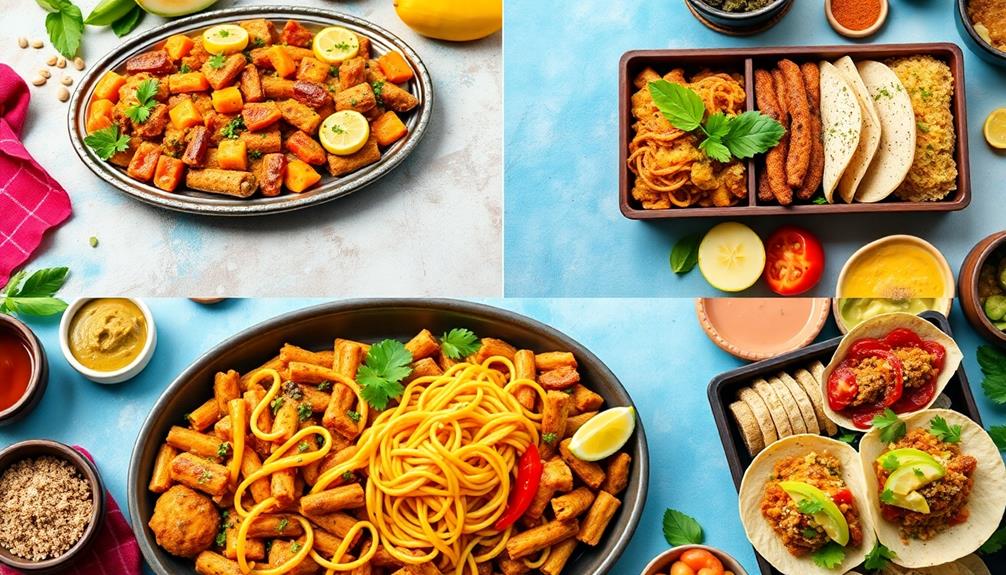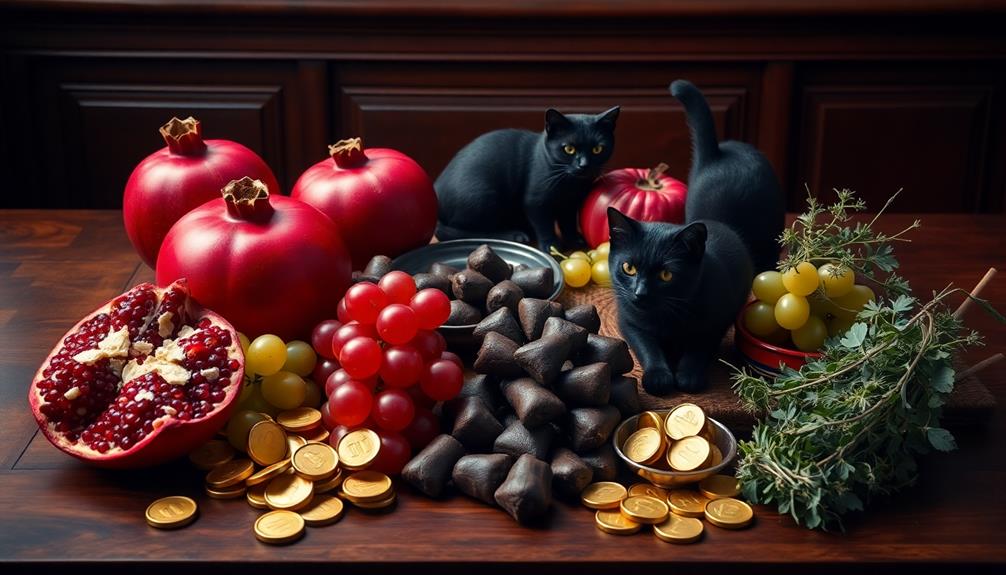Different cultures approach leftovers in varied ways. For instance, Argentinians save almost every bit of food, while only 5.1% of Spaniards do the same. In the U.S., you'll find creative uses for Thanksgiving turkey, turning it into soups or sandwiches. Meanwhile, countries like Poland see increased food waste despite their abundance. There's also a significant difference in food safety practices; while some cultures leave food out, others prioritize quick refrigeration. Understanding these diverse attitudes can help reduce waste. If you're curious about more insights and practices from around the world, there's plenty more to explore.
Key Takeaways
- Food storage practices for leftovers vary widely; U.S. consumers tend to refrigerate quickly, while Estonians may leave food at room temperature.
- In Argentina, 100% of respondents save leftovers, contrasting sharply with only 5.1% in Spain, highlighting diverse cultural attitudes.
- Historical influences, such as social hierarchies and Renaissance critiques, shaped modern perceptions of food waste and resourcefulness in many cultures.
- Culinary innovation promotes zero waste, with chefs creating recipes that transform leftovers into new dishes, reflecting cultural resourcefulness.
- Community initiatives, like food-sharing groups, emphasize the importance of sustainability and reducing food waste through cultural engagement.
Cultural Perspectives on Leftovers
When you think about leftovers, it's fascinating to see how cultures around the world treat them. Some societies have historically embraced a resourceful approach, using every scrap of food to minimize waste. Pre-industrial communities often repurposed leftovers, making it second nature to transform what was left into nourishing meals.
For example, in the U.S., leftover turkey from Thanksgiving is often creatively used in dishes like Turkey Soup or sandwiches. However, cultural perspectives can shift dramatically. In Poland, for instance, the change to a more abundant lifestyle after 1989 has led to increased food waste, with families throwing away food worth an average of 200 zloty each month.
Conversely, culinary literature is now emphasizing zero waste practices, encouraging innovative recipes that celebrate leftovers. This shift isn't limited to Poland; globally, social movements are promoting food sharing and local recovery initiatives.
These efforts highlight the need to rethink our attitudes towards leftovers and food waste. In the U.S., many consumers discard 68% of edible food, pointing to a disconnect from traditional practices. By embracing cultural perspectives that value leftovers, you can contribute to reducing food waste and fostering a more sustainable food culture.
Historical Context of Food Waste
Throughout history, food waste has been shaped by social hierarchies and cultural attitudes. In places like Old Poland, the wealthy often discarded leftover scraps, leaving the poor hungry and emphasizing the stark divide between social classes.
During the Renaissance, critics began to point out the absurdity of affluent wastefulness, prompting a change in awareness. By the 19th century, cookbooks emerged that championed frugality and the creative use of leftovers, urging households to make the most of available resources. This resourcefulness is reflected in various culinary traditions, such as the Ethiopian practice of transforming leftover injera into dishes like Yetimatim Fitfit, showcasing how communities can creatively repurpose food.
Figures like Teresa Prażmowska highlighted a moral obligation to remember the hungry, advocating against waste and promoting resourcefulness. Efficient households understood the value of food scraps, turning them into delicious dishes rather than allowing them to rot.
Publications began to circulate recipes specifically designed for leftovers, emphasizing a practical approach to food waste.
Cultural attitudes towards frugality intensified during occupation periods, as communities faced scarcity. This change forced many to rethink their relationship with food, evolving from abundance to resource-consciousness.
In this historical context, food waste wasn't just an issue of sustainability but also one of ethics, community, and survival.
Modern Practices and Attitudes
Today, you might notice that attitudes toward leftovers vary widely, influenced by cultural norms and personal habits.
In some Southern households, dishes like squash casserole and creamed corn are often saved for later, showcasing a deep appreciation for comfort food and its role in family gatherings.
While some folks prioritize health and safety by quickly storing their food, others may let it sit out longer than recommended.
Innovative storage solutions are emerging to help you keep leftovers fresh, but societal views still often underestimate their value.
Cultural Attitudes Toward Leftovers
Across the globe, cultural attitudes toward leftovers reveal a captivating tapestry of practices and beliefs. In Argentina, you'd find a remarkable 100% of respondents saving their leftovers, showcasing a strong cultural tradition of reusing food. In contrast, only 5.1% of people in Spain share this mindset, highlighting the regional differences in attitudes toward food storage.
Notably, many Indian dishes, such as Mushroom Masala, are often enjoyed as leftovers, with the flavors intensifying over time, reflecting a culinary appreciation for reusing food. In Estonia, over half of participants leave food at room temperature for extended periods, suggesting a relaxed approach to food safety.
Meanwhile, in the U.S., nearly half of you save leftovers two to seven days a week, yet 12.4% believe meat dishes can be safely stored for up to a week, revealing some misconceptions about food spoilage.
Colombian respondents present another angle, with 13.1% of low-income individuals never saving leftovers, indicating that economic factors greatly shape your attitudes toward food reuse. Additionally, 87% of Argentinians believe fresh salads can last only 1-2 days, reflecting varied perceptions of food freshness and safety across cultures.
Health and Safety Practices
Cultural attitudes toward leftovers not only shape how food is reused but also influence modern health and safety practices. You might be surprised to learn how these practices vary across cultures.
For instance, in Estonia, over half of the participants reported leaving food at room temperature for hours, while only a quarter of Russians and Argentinians did the same. This highlights differing views on food safety. In many Asian cultures, such as in China, preserving and reusing food is celebrated through traditional dishes like Red-Braised Pork Belly, showcasing the value of repurposing leftovers in flavorful ways.
In many countries, people use sensory methods to assess food safety, with 25%-29% of consumers in Colombia, Estonia, and Spain relying on sight, smell, and taste. Additionally, while over 80% of individuals save leftovers, Colombia had a notable 13.1% who never do.
Here are some key points to take into account about leftover practices:
- Misconceptions about food spoilage, like the 12.4% of U.S. respondents who believe meat can last a week.
- Higher education correlates with better food safety practices.
- Special containers are preferred by high-income individuals in places like the U.S. and Italy.
- Cultural practices greatly shape attitudes toward food consumption and storage behaviors.
Understanding these differences can enhance your approach to food safety.
Innovative Storage Solutions
Many people are embracing innovative storage solutions to make the most of their leftovers, reflecting a shift in modern food preservation practices. In the U.S. and Italy, over 80% of individuals save leftovers, showcasing a cultural acceptance of this practice. High-income folks in these countries often opt for special containers designed for leftover storage, emphasizing organization and efficiency in managing their food.
This trend aligns with the growing interest in farm-to-table cooking, as individuals seek to maximize the use of fresh, local ingredients, including those that might otherwise be wasted.
Interestingly, in Colombia, the preference for these specialized containers is particularly stronger among women than men, illustrating gendered differences in food storage approaches. Meanwhile, Estonian respondents take a practical route, favoring cooking containers for their leftovers, which highlights convenience as a priority.
Despite these positive trends, there's still a critical need for better education on food safety. For instance, 12.4% of U.S. respondents mistakenly think meat can be stored for up to a week.
Understanding proper storage times is essential to guarantee your innovative solutions don't lead to food waste or safety issues. By staying informed and adopting these modern practices, you can effectively enjoy your leftovers while minimizing waste and maximizing your food experience.
Regional Differences in Storage
When it comes to storing leftovers, you'll notice that cultural practices vary widely by region.
For instance, while you might quickly pop your food in the fridge after a meal in the U.S., others, like those in Estonia, leave it out for hours.
In Brazil, traditional dishes like Caldeirada may be enjoyed over multiple days, showcasing the importance of communal eating and the way flavors develop over time.
Understanding these differences in timing and container preferences can shed light on the broader cultural attitudes towards food storage.
Cultural Storage Practices
Storage practices for leftovers vary widely across regions, reflecting distinct cultural attitudes toward food safety and preservation. In the U.S., you might find nearly half of people saving leftovers two to seven days a week, showcasing a strong repurposing culture. In contrast, countries like Colombia and Spain show a notable percentage of respondents who never save leftovers, indicating different views on food storage.
For instance, traditional dishes like Muamba De Galinha from Angola often emphasize fresh preparation, with families gathering to enjoy meals rather than storing them for later.
Here are some key insights into these cultural practices:
- Estonians often leave food at room temperature for several hours, with 55.8% doing so.
- Older U.S. consumers typically store food within an hour after preparation, emphasizing caution.
- Over 80% of U.S. and Italian participants prefer special containers for storing leftovers.
- In Argentina, 87% believe fresh salads last only 1-2 days, highlighting differing perceptions of food safety.
These examples illustrate how cultural attitudes shape food storage behaviors, influencing everything from the types of containers used to the time left before refrigeration.
Understanding these regional differences can enhance your appreciation for global food practices and promote better food safety habits.
Time Before Refrigeration
Cultural attitudes toward food safety markedly influence how long people leave leftovers unrefrigerated. In the U.S., Spain, Russia, Italy, and Argentina, about half of the participants reported letting food sit out for 30 minutes to an hour before refrigerating it. In contrast, Colombia and Estonia show different practices. Nearly 40% of Colombians leave food at room temperature for up to two hours, while a notable 55.8% of Estonians do so for even longer, raising concerns about food safety.
This can be seen in the way traditional dishes like Chilaquiles utilize leftover tortillas, reflecting a cultural appreciation for minimizing waste and making the most of available ingredients.
Interestingly, older adults in the U.S. tend to follow stricter food safety guidelines, often refrigerating food within an hour after preparation. Younger individuals in Argentina, however, are more relaxed about this, frequently leaving food at home unrefrigerated for extended periods.
Sensory assessment plays a role too; 25%-29% of consumers in Colombia, Estonia, and Spain rely on their senses to judge food safety before deciding whether to throw away food.
These cultural practices shape how people perceive food safety and the acceptable timeframe for leaving leftovers out, which varies markedly across regions.
Container Preferences by Region
Across the globe, people show distinct preferences for how they store their leftovers, reflecting unique cultural attitudes toward food preservation. In the U.S. and Italy, many prefer using specialized containers, highlighting a cultural emphasis on organized storage.
This contrasts with Estonia, where cooking containers are favored, indicating a practical approach that leverages existing kitchen materials. Additionally, how different cultures view food preservation can also be seen in their culinary practices, such as the Japanese tradition of using ingredients like Umeboshi (Pickled Plum) to enhance dishes and reduce waste.
Interestingly, gender differences emerge in Colombia, where women lean more towards using special containers than men do. Socioeconomic status also plays a role; high-income individuals in both the U.S. and Italy tend to opt for specialized storage solutions. This indicates that not only culture but also financial means influence container preferences.
Here are some factors that contribute to these regional differences:
- Cultural emphasis on organization in the U.S. and Italy.
- Practicality in Estonian storage methods.
- Gender influences in Colombia's container choices.
- Socioeconomic status affecting storage solutions.
These variations underscore how diverse cultural attitudes shape our everyday practices regarding leftovers and food preservation.
Innovations in Leftover Utilization
As chefs and home cooks alike embrace innovative ways to use leftovers, the culinary world is witnessing a shift towards sustainability. Culinary literature focusing on zero waste is gaining traction, promoting creative recipes that breathe new life into wasted food.
For instance, you might transform stale bread into delightful desserts or repurpose brewer's grain into cakes. Upcycling in food production is becoming a crucial concept, encouraging food producers to turn by-products into higher-value products.
Community initiatives, like the New Epiphanies Festival, highlight the cultural significance of using leftovers, inspiring you to adopt sustainable eating practices that reduce food waste.
Chefs such as Michał Czekajło advocate for zero waste cooking by incorporating local ingredients and personal memories into their dishes, showcasing flexibility and resourcefulness in using leftovers.
This revival of historical practices, where every part of produce was utilized, reinvigorates your kitchen approach. By reimagining leftover materials, you're not just combating wasted food but also cultivating a mindful connection to your meals.
Embracing these innovations allows you to contribute to a more sustainable future while enjoying delicious, inventive dishes.
Social Movements and Sustainability
Social movements have stepped up to promote sustainability, particularly in how we handle food waste. These initiatives focus on changing societal attitudes towards leftovers, transforming them from waste into valuable resources.
You can get involved in various ways that support the zero waste movement and encourage food sharing.
- Join local food-sharing groups to redistribute excess food.
- Participate in community awareness campaigns that educate on sustainable practices.
- Attend events like the New Epiphanies Festival to engage with others about food waste.
- Explore culinary literature that showcases creative uses for leftover ingredients.
Grassroots initiatives, such as Freeganism, challenge conventional norms by encouraging people to salvage food from dumpsters for redistribution. This movement highlights the need for access to food while confronting wastefulness.
In Poland, the integration of zero waste principles into cooking reflects a cultural shift, with traditional recipes evolving to incorporate leftovers effectively. Such social movements not only promote sustainability but also foster a sense of community, making it easier for individuals to adopt a zero waste lifestyle.
Frequently Asked Questions
How Does Culture Influence the Food We Eat?
Culture shapes your food choices, influencing what you eat, how you prepare meals, and even dining rituals. It defines flavors you crave, ingredients you prefer, and the significance of sharing meals with others.
What Are the Cultural Beliefs About Food?
Food's like a vibrant tapestry woven with cultural beliefs; you'll find traditions that celebrate every morsel and others that dismiss leftovers. Embracing these beliefs shapes your meals, transforming dining into a rich, communal experience.
What Are the 10 Creative Ways to Use Leftovers?
You can transform leftovers into exciting meals by making stir-fries, casseroles, soups, frittatas, or fried rice. Try turning stale bread into croutons or breadcrumbs, and repurpose cooked veggies for delicious, nutritious dishes.
What Is a Good Way to Use Leftovers in a New or Different Way or Meal?
Imagine a treasure chest filled with forgotten jewels. You can transform yesterday's meal into a vibrant stir-fry, mixing those remnants with fresh veggies and spices, creating a delightful feast that breathes new life into your kitchen.
Conclusion
As you explore how different cultures embrace leftovers, you realize some see them as treasures to be savored, while others view them as burdens to discard. This contrast highlights a deeper conversation about sustainability and respect for food. In a world where waste is rampant, it's inspiring to witness innovative practices that transform yesterday's meals into today's delights. By appreciating these diverse approaches, you can contribute to a more mindful relationship with food that honors both tradition and the planet.









